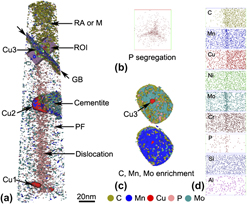Crossref Citations
This article has been cited by the following publications. This list is generated based on data provided by
Crossref.
Liu, Q. D.
Liu, W. Q.
and
Zhao, S. J.
2012.
3D atom probe characterization of temporal evolution of precipitates in aging Nb-V micro-alloyed steel.
Metals and Materials International,
Vol. 18,
Issue. 6,
p.
1009.
Liu, Qingdong
and
Zhao, Shijin
2012.
Cu precipitation on dislocation and interface in quench-aged steel.
MRS Communications,
Vol. 2,
Issue. 4,
p.
127.
Liu, Qingdong
Gu, Jianfeng
and
Liu, Wenqing
2013.
On the Role of Ni in Cu Precipitation in Multicomponent Steels.
Metallurgical and Materials Transactions A,
Vol. 44,
Issue. 10,
p.
4434.
Liu, Qing-Dong
and
Zhao, Shi-Jin
2013.
Comparative Study on Austenite Decomposition and Cu Precipitation During Continuous Cooling Transformation.
Metallurgical and Materials Transactions A,
Vol. 44,
Issue. 1,
p.
163.
Liu, Qing-Dong
Gu, Jian-Feng
and
Li, Chuan-Wei
2014.
Regulation of Cu precipitation by intercritical tempering in a HSLA steel.
Journal of Materials Research,
Vol. 29,
Issue. 8,
p.
950.
Liu, Qingdong
Li, Chuanwei
Gu, Jianfeng
and
Liu, Wenqing
2014.
Direct observation of Cu interphase precipitation in continuous cooling transformation by atom probe tomography.
Philosophical Magazine,
Vol. 94,
Issue. 3,
p.
306.
Lin, Mu
Zhao, Xingfeng
Han, Lizhan
Liu, Qingdong
and
Gu, Jianfeng
2016.
Microstructural Evolution and Carbide Precipitation in a Heat-Treated H13 Hot Work Mold Steel.
Metallography, Microstructure, and Analysis,
Vol. 5,
Issue. 6,
p.
520.
Shahriari, Babak
Vafaei, Reza
Sharifi, Ehsan Mohammad
and
Farmanesh, Khosro
2017.
Continuous cooling transformation behavior and the kinetics of bainite formation in a bainitic–martensitic steel.
International Journal of Materials Research,
Vol. 108,
Issue. 9,
p.
715.
Liu, Qingdong
and
Gu, Jianfeng
2017.
Hierarchical Cu precipitation in lamellated steel after multistage heat treatment.
Philosophical Magazine,
Vol. 97,
Issue. 27,
p.
2361.
Liu, Qingdong
Li, Chuanwei
and
Gu, Jianfeng
2017.
Interactive formation of Cu-rich precipitate, reverted austenite, and alloyed carbide during partial austenite reversion treatment for high-strength low-alloy steel.
Journal of Materials Research,
Vol. 32,
Issue. 12,
p.
2325.
Liu, Qingdong
Chen, Yihua
Li, Chuanwei
and
Gu, Jianfeng
2018.
Compositional Variants of Cu-rich Precipitate in Thermally Aged Ferritic Steel.
Acta Metallurgica Sinica (English Letters),
Vol. 31,
Issue. 5,
p.
465.
Gong, P.
Liu, X.G.
Rijkenberg, A.
and
Rainforth, W.M.
2018.
The effect of molybdenum on interphase precipitation and microstructures in microalloyed steels containing titanium and vanadium.
Acta Materialia,
Vol. 161,
Issue. ,
p.
374.
Yi, Yanliang
Xing, Jiandong
Ren, Xiangyi
and
Yi, Dawei
2018.
Metastable bcc-Cu precipitation behavior and its effect on microstructure and strengthening of as-cast Fe–B alloy containing 3 wt% copper content.
Materials Research Express,
Vol. 6,
Issue. 2,
p.
026569.
Kong, H.J.
Xu, C.
Bu, C.C.
Da, C.
Luan, J.H.
Jiao, Z.B.
Chen, G.
and
Liu, C.T.
2019.
Hardening mechanisms and impact toughening of a high-strength steel containing low Ni and Cu additions.
Acta Materialia,
Vol. 172,
Issue. ,
p.
150.
Yoo, Jisung
Choi, Won-Mi
Sohn, Seok Su
Lee, Byeong-Joo
Kim, Gi-Yong
Kim, Hyungjun
Choi, Won-Doo
Oh, Yong-Jun
and
Lee, Sunghak
2019.
Effects of V or Cu Addition on High-Temperature Tensile Properties of High-Ni-Containing Austenitic Cast Steels Used for High-Performance Turbo-Charger Housings.
Metals and Materials International,
Vol. 25,
Issue. 2,
p.
285.
Wang, Sui
Wu, Yake
Zhang, Tengyu
and
Jiang, Feng
2020.
Copper Precipitation Behavior during Continuous Cooling and Subsequent Aging of Powder-Forged Fe-2.5Cu-C Alloy.
Metals,
Vol. 10,
Issue. 10,
p.
1350.
Kong, Haojie
Jiao, Zengbao
Lu, Jian
and
Liu, Chain Tsuan
2021.
Low-carbon advanced nanostructured steels: Microstructure, mechanical properties, and applications.
Science China Materials,
Vol. 64,
Issue. 7,
p.
1580.
Yin, Daniel
Misra, Amit
and
Mazumder, Jyoti
2022.
Modeling of non-equilibrium partitioning in direct metal deposited copper–iron concentrated alloys.
Journal of Materials Research,
Vol. 37,
Issue. 3,
p.
705.
Xiao, Yajiao
Xiong, Xiangyuan
Sun, Guangyan
Sun, Mengju
and
Liu, Wenqing
2022.
Atom probe characterization of Cu-rich precipitates in different phases of 15–5 PH stainless steel in over-aged condition.
Materials Characterization,
Vol. 191,
Issue. ,
p.
112184.
Lashgari, H.R.
Adabifiroozjaei, E.
Kong, C.
Molina-Luna, Leopoldo
and
Li, S.
2023.
Heat treatment response of additively manufactured 17-4PH stainless steel.
Materials Characterization,
Vol. 197,
Issue. ,
p.
112661.



